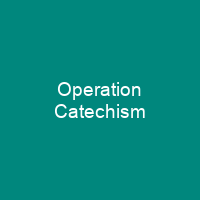Operation Catechism: A Turning Point in World War II
Imagine a moment when the fate of an entire nation hung by a thread, and one daring operation could change everything. That’s what Operation Catechism was like on November 12, 1944. This air raid, conducted by the Royal Air Force (RAF), targeted the German battleship Tirpitz, which had been wreaking havoc in northern Norway. The operation aimed to end a series of attacks that had left the Allies frustrated and determined.
The Plan: A Bold Move
For months, the RAF had been planning this mission with meticulous care. They knew they needed something special—something that could penetrate the thick armor of Tirpitz. The Tallboy bomb was their answer. These bombs were designed to drop from high altitudes and punch through a battleship’s deck before exploding inside, causing catastrophic damage.
Preparation: A Race Against Time
The Lancasters, the chosen bombers for this mission, were stripped of non-essential equipment to carry more fuel. This meant they would have to fly over hostile territory with minimal protection against German fighter planes. The crews knew the risks but were driven by a sense of urgency and duty.
Execution: A Test of Skill
The operation began on November 12, 1944, under clear skies. However, as the bombers approached their target, they encountered clouds that made accurate targeting impossible. Despite this setback, 33 aircraft managed to drop their bombs, but none hit Tirpitz. The battle was far from over.
The Final Blow: A Moment of Triumph
On the morning of November 12, 1944, a force of 38 fighters was transferred to Bardufoss. However, most pilots were inexperienced and ill-trained. Despite these challenges, the weather cleared just in time for the final attack. At 9:41 am, Tait’s aircraft dropped a Tallboy bomb that struck Tirpitz. By 9:52 am, the battleship had capsized, resulting in the deaths of almost 1,000 crew members.
Impact and Legacy
The destruction of Tirpitz was a significant victory for the Allies. It freed up resources that could be deployed elsewhere, and it marked a turning point in the war against Nazi Germany. The operation led to celebrations worldwide, with King George VI, Prime Minister Winston Churchill, and even President Roosevelt congratulating those involved.
A Symbol of Triumph
Operation Catechism was more than just a military victory; it was a symbol of the Allied resolve and technological prowess. The battle highlighted the importance of precision bombing and the effectiveness of the Tallboy bomb in naval warfare. It also underscored the challenges faced by air crews, who had to navigate treacherous conditions and enemy defenses.

Operation Catechism stands as a testament to the bravery and ingenuity of those who fought in World War II. It was a moment when the skies over northern Norway turned into a battlefield, where the fate of nations hung by a thread. The legacy of this operation continues to inspire us today, reminding us of the power of determination and the importance of strategic planning.
You want to know more about Operation Catechism?
This page is based on the article Operation Catechism published in Wikipedia (retrieved on November 28, 2024) and was automatically summarized using artificial intelligence.







